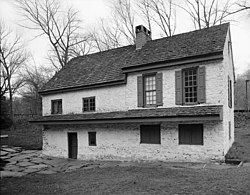RittenhouseTown Historic District
|
Rittenhousetown Historic District
|
|

Rittenhouse homestead
|
|
| Location | 206–210 Lincoln Drive, Philadelphia, Pennsylvania |
|---|---|
| Coordinates | 40°1′43″N 75°11′28″W / 40.02861°N 75.19111°WCoordinates: 40°1′43″N 75°11′28″W / 40.02861°N 75.19111°W |
| Area | 84 acres (34 ha) |
| Built | 1690–1732 |
| Architectural style | Georgian, Federal |
| NRHP Reference # | 92001878 |
| Significant dates | |
| Added to NRHP | April 27, 1992 |
| Designated NHLD | April 27, 1992 |
| Designated PHMC | April 8, 1991 |
The Rittenhousetown Historic District was an early industrial community where the first paper mill in British North America was built by William Rittenhouse and his son Nicholas on the north bank of Monoshone Creek near Philadelphia, Pennsylvania. Flax was woven into linen in nearby Germantown. When the linen fabrics wore out, the rags were brought to Rittenhousetown to be made into paper. Paper produced at the Rittenhouse mill was sold to printers in Germantown, Philadelphia, and New York City. In 1890, Rittenhousetown became part of the Germantown section of Philadelphia.
The site was acquired through donations and several purchases by the City of Philadelphia through the Fairmount Park Commission over the years from 1890 to 1917.
It was listed on the National Register of Historic Places and was designated a National Historic Landmark District on April 27, 1992.
Historic RittenhouseTown, Inc. was formed in 1984 to preserve, restore, and historically interpret RittenhouseTown. The group maintains five historic buildings: Abraham Rittenhouse Home (c. 1720), which serves as the visitor center; Rittenhouse Homestead (1707); Enoch Rittenhouse Home; Jacob Rittenhouse Home; and the Rittenhouse Home. There is also a barn and bakehouse that are used for paper-making and cooking demonstrations.
...
Wikipedia

